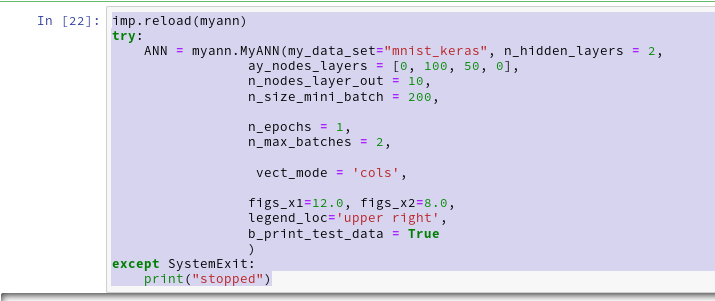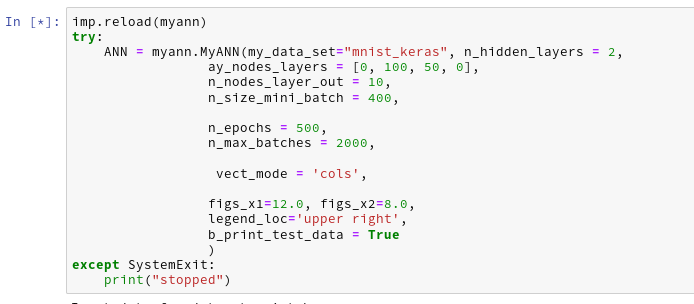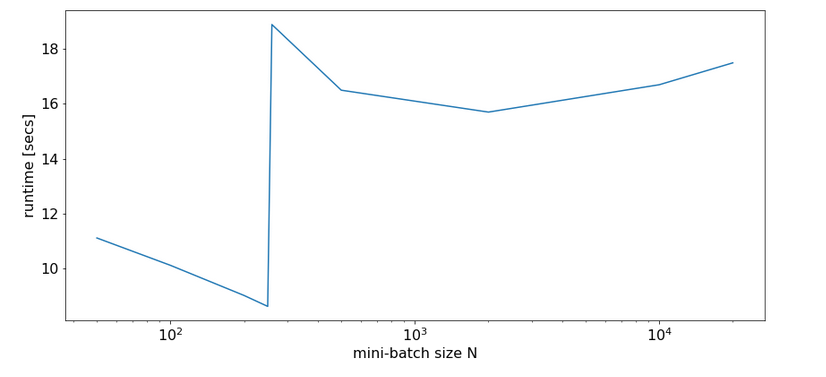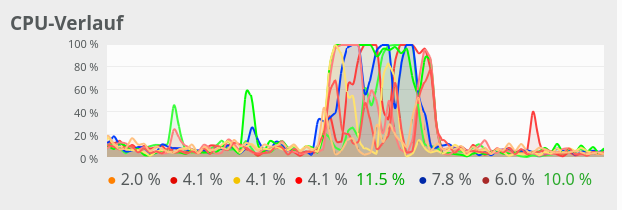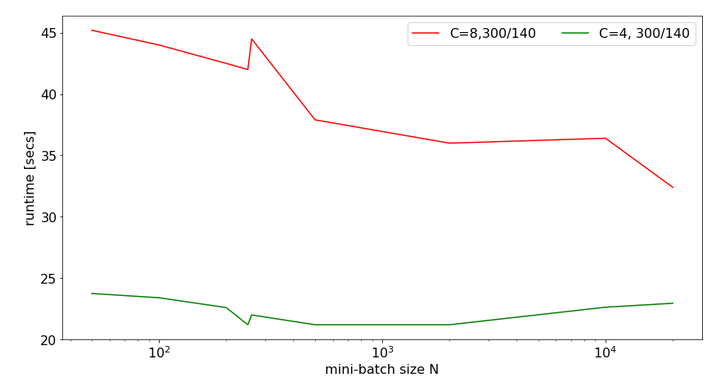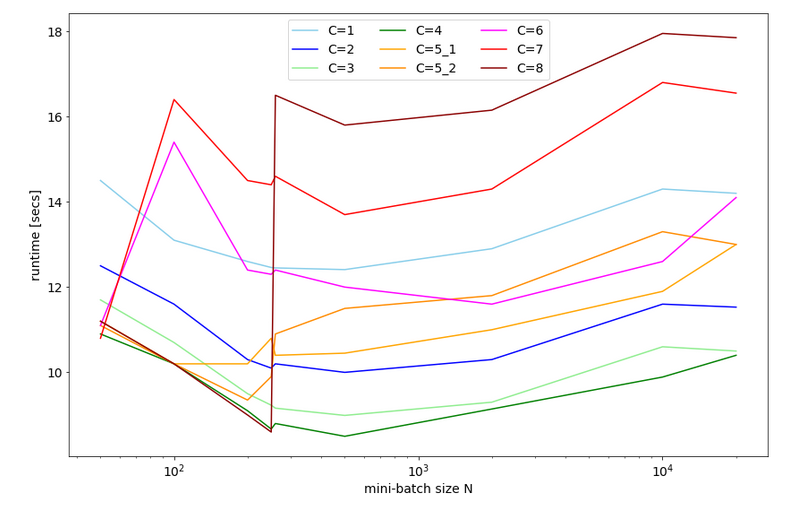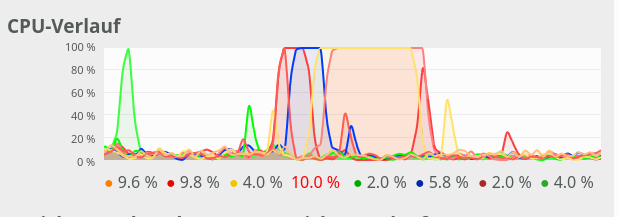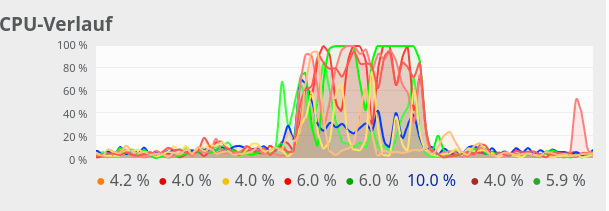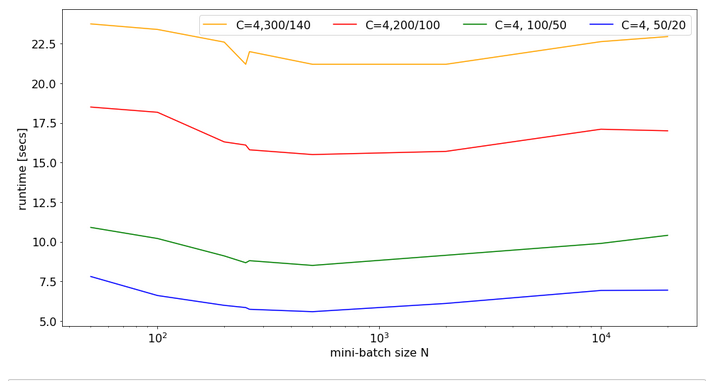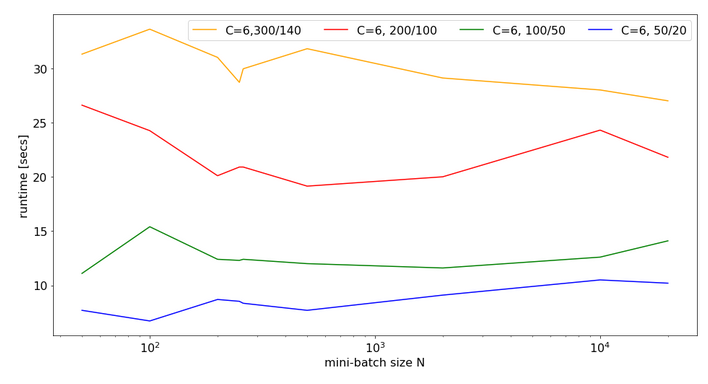We continue with our effort to write a Python class for a Multilayer Perceptron [MLP] – a simple form of an artificial neural network [ANN]. In the previous articles of this series
A simple program for an ANN to cover the Mnist dataset – III – forward propagation
A simple program for an ANN to cover the Mnist dataset – II – initial random weight values
A simple program for an ANN to cover the Mnist dataset – I – a starting point
I have already explained
- what parts of an MLP setup we need to parameterize; e.g. the number of layers, the number of nodes per layer, the activation and output functions;
- how we create node layers and the corresponding weight arrays,
- how (and also a bit of why) we work with “mini-batches” of test data during training,
- how we can realize a “vectorized” form of the required “Feed Forward Propagation” algorithm [FFP]. A vectorized form enables us to process all training data records of a mini-batch in parallel. We used Linear Algebra functions provided by Numpy for this purpose; these functions are supported by the the OpenBlas library on a Linux system.
We also set up a basic loop over a number of epochs during training. (Remember: An epoch corresponds to a training step over all training data records). The number of epochs is handled as a parameter to the class’s interface. By artificially repeating the FFP algorithm up to a thousand times, we already got an impression of the code’s performance and its dependence on the number of CPU cores and the size of a mini-batch.
A special method of our class MyANN controls the handling of a mini-batch of multiple input data records via two major steps so far:
- Step 1: Extract the data records for the mini-batch from the input data.
- Step 2: Apply FW-propagation to all data records of the mini-batch.
The next natural step would be to encode a training algorithm which optimizes the weight parameters of our MLP. However, in this article we shall not code anything. Instead, I shall discuss some aspects of the so called “cost function” of a MLP. I think this to be useful to get a basic understanding of what training of an ANN actually means and what the differences are in comparison to other ML-algorithms as e.g. the SVM approach. Understanding the cost function’s role for the training of a MLP will also help to better understand the origin and the mathematical form of the back-propagation-algorithm used for training and discussed in a later article.
I simplify a lot below; more details can be found in the literature on machine Learning [ML]; see the section “Links” for some references. Note that if you know all about the theoretical concepts behind ANN training you will not learn anything new here. This is for beginners (and for later reference in this article series).
The concept of a cost function: Turning a classification problem into an optimization problem
What do we mean by training an ANN? Training means to optimize the weights of the ANN such that the “Feed Forward Propagation” in the end delivers correct predictions for new datasets. A cost function is a central concept of the so called “gradient descent method” used for this optimization. By the way: A synonym for cost function is “loss function”. We use both terms
alike below.
The relation between ANN-training based on a loss function and the classification task, which we want to solve with an ANN, is a subtle one. Let us first discuss what we understand by “classification”:
Classification means to separate the input data into categories; i.e.: finding categorical separation surfaces in the multidimensional vector space of input data. In case of the MNIST dataset such separation interfaces should discriminate between 10 different clusters of data points.
I have discussed the problem of finding a separation surface for the case of the moons dataset example in previous articles in this blog. We then used SVM-algorithms to solve this particular problem. Actually, we determined parameters of (non-linear) polynomials to define a separation surface with a (soft) maximum distance from category related clusters of data points in an extended feature space (=input vector space). The extended feature space covered not only basic features of the input data but also powers of it.
All in all we worked directly in an multidimensional extension of the input vector space and optimized parameters describing linear separation interfaces there. If we had several categories instead of 2 we could use a so called “one versus all”-strategy to calculate 10 linear separation interfaces and determine the distance of any new data point towards the separation surfaces as a confidence measure (score) for a prediction. The separation with the highest score would be used to discriminate between the 10 possible solutions and choose the optimal one. Yes, working in an extended input vector space and with parameters of multiple linear separation surfaces was a bit difficult.
Actually, working with ANNs and cost functions corresponds to a more elegant way of optimizing; it starts with measuring distances in the output vector space of the ANN/MLP:
In the context of classification tasks (with known results for training data) a loss function provides a fictitious cost value which weighs the deviations (or distances) of calculated result values (of the ML-algorithm under training) from the already known correct result for training records. I.e. it measures the errors for the training data records in the output space. The optimization task then means to minimize the cost function and thereby minimize a kind of mean error for all input data records.
The hope is that the collection of resulting weight values allows for predictions of other unknown input data, too.
The result of an ANN/MLP for a training data record is the outcome of a complex transformation performed by the ANN. In case of an MLP the transformation of input into output data is done by the “Feed Forward Propagation” algorithm [FFP]. Thus a reasonably designed cost function becomes dependent on the parameters of the FFP-algorithm – predominantly on the weights given at the nodes of the MLP’s layers. We concentrate on this type of parameter below; but note that in special ANN cases there may be additional other parameters to be varied for training and ANN optimization.
The MLP’s weights can in principle be varied continuously during training. The parameter (vector) space thus can be described by multiple real value axes – one for each of the weights. The parameter space of a MLP is a multi-dimensional one with a dimension equal to or bigger than the space of input data – and of course also the result space. (That the dimension is bigger follows from the required node number in the input layer.)
With the help of a suitable cost function we can pose a mathematical optimization problem for the weight parameters:
Find a point in the weight vector space for which the cost
function gives us a minimum, which in turn corresponds to an overall minimum of the deviation distances.
A simple example for a cost function would be a sum of square values for the length of the difference vectors in the output space for all training data.
There are several things to mention:
- The result space is a multidimensional vector space (in case of MNIST a 10 dimensional one); so the distance between points there has to be defined via a mathematical norm over components.
- The result space in classification problems typically has a much smaller dimension “m” than the dimension “n” of the space of the input data (m < n).
- It makes almost no sense to display the cost function over the multidimensional space of input data – as a working ML-algorithm should deliver small cost values for all input data. However, it makes a lot of sense to display the costs over the multi-dimensional vector space of continuous weight values.
- We deal with batches of many training data records; it follows that a reasonable cost function in this case must combine deviations of individual records from optimal values. This is very often done via some kind of sum over individual cost contributions from each training record.
A continuous differentiable cost function defines a hyperplane for gradient-descent
In many MLP cases the cost function will be a function of the weight parameters only; this requires a reasonable node independent form of the activation functions. A loss function with a continuous dependency on all ANN parameters (as the weights) provides a multidimensional hyperplane in an (n+1)-dimensional space – with “n” being the number of FFP variables. The (n+1)-th dimension is for the cost values. As the the FFP-algorithm depends on a multitude of linear and non-linear operations we expect that the hyperplane-surface will have a rather complex form – with maxima and minima as well as so called saddle points.
However, if we construct the cost function cleverly the optimum values for the ANN’s weights will lead to a global minimum of this hyperplane – which then in turn corresponds to a minimum of distances between the propagation results and the known values for the training data:
The task to find categorical separation surfaces in the vector space of input data is reformulated as an optimization task in the cost-weight vector space: There it means finding a (global) minimum of the cost hyperplane.
Let us assume we sit at some point on a yet unexplored hyperplane. A quite general way to find the (global) minimum of this hyperplane is to follow a path indicated by the (tangential) gradient vector at the local point: The gradient is vertically oriented with respect to contour lines of constant cost values on the hyperplane. It thus gives us the direction along which a maximum cost change occurs per unit change of some weights. Calculating corrections of the weights translates into following the gradient with small steps. Geometrically speaking:
We follow the direction the overall gradient points to – and translate the movement into to small components along each weight axis – which gives us the individual weight corrections. Our hope is that the overall gradient points into the direction of the global minimum. (In case of local minima or large planes of the hyperplane we would have to adopt the step size somehow.)
This is called the “gradient descent method“. In one of the next contributions to this article series we shall see how this in turn efficiently translates into the backward propagation of errors through the network via matrix operations. Our optimization task is thus reduced to a
systematic variation of the weights during gradient descent with a series of mathematical operations determining gradient components and resulting weight corrections.
Smooth or stochastic gradient descent?
The cost function absorbs complexity stemming from the large amount of all training data rather smoothly by summing up the individual contributions of training data records. Let us look a bit at the gradient: Normally we would have to calculate partial derivatives of all cost contributions off all data sets with respect to all individual weights. For big training data sets this corresponds to a lot of mathematical operations – both matrix operations (linear algebra) and value calculations of nonlinear (activation and output) functions.
What happens if we took not all data records but concentrated on the contributions of selected input data, only? And corrected afterwards again for another disjunctive set of selected data points? I.e. what if we calculated the full required correction only piece-wise for different collections (mini-batches) of input data records?
Then the reduced gradient components would guide us into a direction on the hyperplane which deviates from the overall gradients direction. Taking the next data record would correct this movement a bit into another direction again. If we perform gradient correction for batches of different data records or in the extreme case for individual records we would move somewhat erratically around the overall gradient’s direction; we speak of a “stochastic gradient descent” [SGD].
The erratic movement of SGD helps to overcome local overall minima. But all in all it may take more steps to come to a global minimum or at least close to it – as the a stochastic movement may never converge into the overall minimum’s point in the weight space – but hop instead around it.
The question of how many input data we include in the cost function determining one single weight correction step during an epoch leads to the choice between the following cases:
- stochastic gradient descent (sequence of weight corrections during an epoch – each based on just one training data record at a time and for all weights),
- full batch gradient descent (one weight correction per epoch – based on all training data records and for all weights),
- mini-batch gradient descent (sequence of weight corrections during an epoch – each based on a batch of multiple training data records and for all weights).
A stochastic or mini-bath based gradient descent may mean much faster corrections in terms of a reduced number of (vectorized) mathematical operations and CPU consumption – at least at the beginning of the descent. The CPU time of the training process for large amounts of input data may actually be reduced by factors!
In the case of mini-batches we can, therefore, optimize the performance by varying the mini-batch size. The required matrix operations can be performed vectorized over all data records of the batch; i.e. the operations can be performed “in parallel”. Fortunately, we do not need to care about the necessary CPU register handling whilst coding – optimized libraries will take care of this. As we have seen already in this blog, also threading for a reasonable amount of CPU cores may influence the performance on a specific system a lot.
For our Python class we will therefore provide parameters for the size of a mini-batch – and adapt both the calculation of cost-contributions and respective weight corrections accordingly.
Note that we do not only hope for that the weights determined by gradient descent provide reasonable result values for the training data but also for any other data later on provided to the ANN/MLP. Solving the optimization problem in the end must provide reliable and complex separation surfaces in
the multidimensional input vector space (for MNIST with a dimension of n=784). The mathematical equivalence of the problem of finding separation surfaces in the input vector space to the optimization problem in the result space can be proven for regression problems. (Actually, I do not know whether a mathematical equivalence has been proven for general problems. So, for some ML classification tasks gradient descent may not work sufficiently well.)
Choosing a cost function
Cost functions should be designed carefully. A “cost function” must have certain properties for the so called “gradient descent method” to work successfully:
- For convenience the global extremum should be a minimum.
- The cost function must be continuous and differentiable with respect to the ANN’s weights.
- The requirement of differentiability translates back to the requirement of differentiable activation and output functions – as we shall see in detail in a later article.
- It should expose a basic convex form in the surroundings of the global minimum (second partial derivatives > 0).
- The “cost function” must have certain properties for making use of an efficient way to calculate gradients, i.e. partial derivatives. We shall see that some reasonable cost functions turn this task into a back propagation of errors. The efficiency comes via similar matrix operations as those used in the forward propagation algorithm.
Besides choosing a cost function carefully also the choice of the activation function is important for the success of gradient descent. The path to global minimum on a hyperplane may also depend on the starting point (defined by the statistically chosen initial weight values) as well as on an adaptive step size (called learning rate).
Most Machine Learning algorithms can incorporate a variety of reasonable “cost functions. For classification tasks often the following cost functions are used:
- Categorial Cross-Entropy
- Log Loss ( = Logistic Regression Loss )
- Relative Entropy,
- Exponential Loss
- MSE (Mean Square Error)
Each of these functions is more or less appropriate for a specific type of classification problem. See the literature for more information on each of these cost functions.
In our code for MNIST-problem we will only include two of these functions as a starting point – Log Loss and MSE. MSE is e.g. used by T. Rashid in his book (see section Links) on building an MLP with Python for the MNIST case. Information on the Log Loss function are provided by the book of Rashka and the book of Geron; see the references in the section “Links” below.
Do we need cost function values at all?
The training of an ANN – i.e. the optimization of weights – does not require the explicit calculation of cost values. The reason for this is of course that gradient descent first of all works with partial derivatives with respect to weights. To calculate them we must use the chain rule with respect to the activation function, the output of lower layers and so on. But the cost values themselves are nowhere required. As a consequence in all of the book of T. Rashid on “Make your Own Neural network” the calculation of costs is never encoded.
Nevertheless, in the next article of this series we shall discuss the code for cost calculations of mini-batches. The reason for this is that we can use the cost values to study the progress of training and the convergence into a minimum: The change of total “costs” provides a way to control and watch the
success of training through its epochs.
Summary and conclusion
The concept of a cost function is central to MLPs and classification tasks: Classification means to separate the input data into categories. The task to find categorical separation surfaces in the vector space of input data is reformulated as an optimization task. This in turn requires us to find a minimum of the cost/loss hyperplane over the multidimensional space of potential weight-parameters. Calculating corrections of the weights during following a gradient guided path to a minimum in turn efficiently translates into the backward propagation of errors through the network via matrix operations.
Links and Literature
https://www.python-course.eu/matrix_arithmetic.php
Gradient descent and cost functions
towardsdatascience.com understanding-the-mathematics-behind-gradient-descent-dde5dc9be06e
ml-cheatsheet readthedocs – gradient-descent.html
page.mi.fu-berlin.de
neural chapter K7.pdf
Regularization
chunml.github.io tutorial on Regularization/
Books
“Neuronale Netze selbst programmieren”, Tariq Rashid, 2017, O’Reilly Media Inc. + dpunkt.verlag GmbH
“Machine Learning mit SciKit-Learn & TensorFlow, Aurelien Geron, 2018, O’Reilly Media Inc. + dpunkt.verlag GmbH
“Python machine Learning”, Seb. Raschka, 2016, Packt Publishing, Birmingham, UK
“Machine Learning mit Sckit-Learn & TensorFlow”, A. Geron, 2018, O’REILLY, dpunkt.verlag GmbH, Heidelberg, Deutschland

